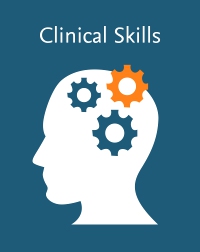
Clinical Skills: Emergency Collection, 1st Edition
Clinical Skills Online

Learn to master the most important nursing skills before you ever step foot in the clinical environment. Clinical Skills: Emergency Collection is an engaging, web-based learning tool that guides users through more than 130 of the most important emergency nursing skills. Next Generation (Next Gen) Skills are the same trusted content, but now with an updated interface and additional course functionality. Each skill in the collection uses the same seven-part framework to walk you through every aspect of the skill. From special patient and safety considerations to the equipment and techniques used in the skill, this assembly of animations, interactive learning tools, and in-depth explanations will leave you with a 360-degree understanding of how to safely and effectively perform each skill.
-
- Convenient web-based program utilizes the same professional format that practicing nurses use to train.
- Consistent, competency-based format for learning skills offers a standardized way for you to learn and perform skills. Most skills feature the same types of skill learning tools to help you obtain a more holistic understanding of the skill and standard QSEN nursing competencies.
- Quick sheet provides a concise, step-by-step summary of the skill.
- Extended text offers an in-depth look at all aspects of the skill. Subjects addressed in the extended text section include:
- Safety alerts
- Supplies
- Patient and family education
- Procedures
- Delegation opportunities
- Monitoring and care
- Expected and unexpected outcomes
- Documentation guidelines
- Special gerontologic, pediatric, and home care considerations
- Evidence-based references
- Additional reading suggestions
- Equipment list helps familiarize you with each piece of equipment needed to perform the skill.
- Demonstration videos and animations visually guide you through every necessary step involved in the skill.
- Images and illustrations highlight crucial procedures, equipment, and documents involved in the skill.
- Competency tests with rationales help you review and evaluate your understanding of the skill.
- Printable evaluation checklists help you measure and track various skill competencies.
- Continually updated, evidence-based content is reviewed and revised annually by clinical skills experts to reflect changes in practice as they arise.
-
Examples of skills in this collection include:
Airway Foreign Object Removal
Airway Positioning
Ambulation Aids: Measuring and Fitting
Ankle-Brachial Index
Antivenin Administration (North America): Scorpion
Antivenin Administration (North America): Snake
Antivenin Administration (North America): Widow Spider
Arthrocentesis and Intraarticular Injection
Arthrocentesis and Intraarticular Injection: Advanced Practice
Assessment: Emergency Primary Survey
Assessment: Emergency Secondary Survey
Assessment: Visual Acuity
Bite Mark Specimen Collection: Human
Bladder Scan
Blood and Fluid Pressure Infusers: Electronic
Blood and Fluid Pressure Infusers: Manual
Blood and Fluid Warmers
Blood Pressure: Orthostatic
Blood Product Administration: Colloids, Cryoprecipitate, Granulocytes, Plasma, and Platelets
Blood Product Administration: Massive Transfusion
Blood Product Administration: Red Blood Cells and Whole Blood
Blood Specimen Collection: Capillary Gases
Body Jewelry Removal
Capnometry and Capnography
Central Venous Catheter: Declotting with a Fibrinolytic Agent
Cerumen Removal
Chest Drain Valves
Cricothyroidotomy
Decontamination
Diagnostic Peritoneal Aspiration and Lavage
Digital Block
Doppler Ultrasound for Assessment of Blood Pressure and Peripheral Pulses
Drug-Assisted Intubation
Dyspnea: Patient Positioning
Ear Wick Insertion
Emergency Childbirth
Emergency Thoracotomy and Internal Defibrillation
Escharotomy
Escharotomy: Advanced Practice
Esophageal Foreign Body Removal
External Jugular Venous Access
Eye Irrigation
Eye Patching
Fibrinolytic Therapy for Acute Ischemic Stroke
Fibrinolytic Therapy for Acute Myocardial Infarction
Fibrinolytic Therapy for Pulmonary Embolism
Fishhook Removal: Advanced Practice
Fluorescein Staining of Eyes
Fluorescein Staining of Eyes: Advanced Practice
Focused Assessment with Sonography in Trauma (FAST): Advanced Practice
Gastric Lavage for Removal of Toxic Substances
Heat Lamp
Helmet Removal
Hyperthermia Measures
Hypothermia Measures
Implantable Cardioverter-Defibrillator: Emergency Management
Incision and Drainage
Incision and Drainage: Advanced Practice
Increased Intracranial Pressure: Patient Positioning
Indirect (Mirror) Laryngoscopy
Interfacility Ground or Air Transport Preparation
Interpretation of Viscoelastic Testing Results
Intracompartmental Pressure Measurement: Advanced Practice
Intracompartmental Pressure Measurement: Assisting
Intraosseous Access
Intravenous Regional Anesthesia
Intravenous Therapy: Ultrasound-Guided Initiation
IV Immunoglobulin (IVIG)
Laryngeal Mask Airway
Laryngeal Tube Airway
Medication Administration: Local Infiltration and Topical Agents for Wound Anesthesia
Nasal Foreign Body Removal: Advanced Practice
Nitrous Oxide
Noninvasive Cardiac Output Monitor
Ophthalmic Foreign Body Immobilization
Ophthalmic Foreign Body Removal
Ophthalmic Foreign Body Removal: Advanced Practice
Oral Airway Insertion
Otic Foreign Body Removal
Oxygen Tank Regulators
Pacing: Transcutaneous
Patient Positioning: Hypotension
Peak Expiratory Flow Measurement
Pelvic Examination
Preservation of Evidence
Pulsus Paradoxus Assessment
Rabies Immunization
Resuscitative Endovascular Balloon Occlusion of the Aorta: Assisting
Ring Removal
Sexual Assault Examination
Shoulder Immobilization
Sling Application
Specimen Collection: Drug and Alcohol
Spinal Motion Restriction
Splinting: Air Splints
Splinting: Finger Immobilization
Splinting: General Principles
Splinting: Knee Immobilization
Splinting: Pelvic
Splinting: Plaster and Fiberglass
Splinting: Traction Splints
Splinting: Vacuum Splints
Strategies to Limit Movement during Pediatric Procedures
Suprapubic Catheter: Insertion: Advanced Practice
Suprapubic Catheter: Insertion: Assisting
Synchronized Cardioversion
T-Piece Adapter for Intubated Patients
Teaching How to Use Ambulation Aids: Cane
Teaching How to Use Ambulation Aids: Walker
Teaching Patients How to Use Ambulation Aids: Crutches
Therapeutic Phlebotomy
Tonometry
Tonometry: Advanced Practice
Tooth Preservation
Tourniquet Application for Hemorrhage Control
Ventilation: Anesthesia Bag
Ventilation: Bag Mask
Ventilation: Mouth to Mask
Whole Bowel Irrigation
Wound Care: Amputation
Wound Care: Minor Burns
Wound Cleaning and Irrigation of Traumatic Wounds
Wound Closure: Skin Adhesive
Wound Closure: Surgical Tape
For a list of all current skills in this collection, please contact your Elsevier Representative. -
This product is available in the following formats:















 as described in our
as described in our 